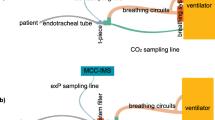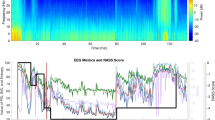Abstract
Propofol in exhaled breath can be detected and monitored in real time by ion molecule reaction mass spectrometry (IMR-MS). In addition, propofol concentration in exhaled breath is tightly correlated with propofol concentration in plasma. Therefore, real-time monitoring of expiratory propofol could be useful for titrating intravenous anesthesia, but only if concentration changes in plasma can be determined in exhaled breath without significant delay. To evaluate the utility of IMR-MS during non-steady-state conditions, we measured the time course of both expiratory propofol concentration and the processed electroencephalography (EEG) as a surrogate outcome for propofol effect after an IV bolus induction of propofol. Twenty-one patients scheduled for routine surgery were observed after a bolus of 2.5 mg kg−1 propofol for induction of anesthesia. Expiratory propofol was measured using IMR-MS and the cerebral propofol effect was estimated using the bispectral index (BIS). Primary endpoints were time to detection of expiratory propofol and time to onset of propofol’s effect on BIS, and the secondary endpoint was time to peak effect (highest expiratory propofol or lowest BIS). Expiratory propofol and changes in BIS were first detected at 43 ± 21 and 49 ± 11 s after bolus injection, respectively (P = 0.29). Peak propofol concentrations (9.2 ± 2.4 parts-per-billion) and lowest BIS values (23 ± 4) were reached after 208 ± 57 and 219 ± 62 s, respectively (P = 0.57). Expiratory propofol concentrations measured by IMR-MS have similar times to detection and peak concentrations compared with propofol effect as measured by the processed EEG (BIS). This suggests that expiratory propofol concentrations may be useful for titrating intravenous anesthesia.



Similar content being viewed by others
References
Boshier PR, Cushnir JR, Mistry V, Knaggs A, Spanel P, Smith D, Hanna GB (2011) On-line, real time monitoring of exhaled trace gases by SIFT-MS in the perioperative setting: a feasibility study. Analyst 136(16):3233–3237. doi:10.1039/c1an15356k
Grossherr M, Hengstenberg A, Meier T, Dibbelt L, Igl BW, Ziegler A, Schmucker P, Gehring H (2009) Propofol concentration in exhaled air and arterial plasma in mechanically ventilated patients undergoing cardiac surgery. Br J Anaesth 102(5):608–613. doi:10.1093/bja/aep053
Harrison GR, Critchley AD, Mayhew CA, Thompson JM (2003) Real-time breath monitoring of propofol and its volatile metabolites during surgery using a novel mass spectrometric technique: a feasibility study. Br J Anaesth 91(6):797–799
Hornuss C, Praun S, Villinger J, Dornauer A, Moehnle P, Dolch M, Weninger E, Chouker A, Feil C, Briegel J, Thiel M, Schelling G (2007) Real-time monitoring of propofol in expired air in humans undergoing total intravenous anesthesia. Anesthesiology 106(4):665–674. doi:10.1097/01.anes.0000264746.01393.e0
Kamysek S, Fuchs P, Schwoebel H, Roesner JP, Kischkel S, Wolter K, Loeseken C, Schubert JK, Miekisch W (2011) Drug detection in breath: effects of pulmonary blood flow and cardiac output on propofol exhalation. Anal Bioanal Chem 401(7):2093–2102. doi:10.1007/s00216-011-5099-8
Miekisch W, Fuchs P, Kamysek S, Neumann C, Schubert JK (2008) Assessment of propofol concentrations in human breath and blood by means of HS-SPME-GC-MS. Clin Chim Acta Int J Clin Chem 395(1-2):32–37. doi:10.1016/j.cca.2008.04.021
Perl T, Carstens E, Hirn A, Quintel M, Vautz W, Nolte J, Junger M (2009) Determination of serum propofol concentrations by breath analysis using ion mobility spectrometry. Br J Anaesth 103(6):822–827
Takita A, Masui K, Kazama T (2007) On-line monitoring of end-tidal propofol concentration in anesthetized patients. Anesthesiology 106(4):659–664. doi:10.1097/01.anes.0000264745.63275.59
Grossherr M, Hengstenberg A, Meier T, Dibbelt L, Gerlach K, Gehring H (2006) Discontinuous monitoring of propofol concentrations in expired alveolar gas and in arterial and venous plasma during artificial ventilation. Anesthesiology 104(4):786–790
Kreuer S, Wilhelm W, Grundmann U, Larsen R, Bruhn J (2004) Narcotrend index versus bispectral index as electroencephalogram measures of anesthetic drug effect during propofol anesthesia. Anesth Analg 98:692–697. doi:10.1213/01.ane.0000103182.78466.ef
Masui K, Kira M, Kazama T, Hagihira S, Mortier EP, Struys MM (2009) Early phase pharmacokinetics but not pharmacodynamics are influenced by propofol infusion rate. Anesthesiology 111(4):805–817
King J, Kupferthaler A, Unterkofler K, Koc H, Teschl S, Teschl G, Miekisch W, Schubert J, Hinterhuber H, Amann A (2009) Isoprene and acetone concentration profiles during exercise on an ergometer. J Breath Res 3(2):027006. doi:10.1088/1752-7155/3/2/027006
Dolch ME, Frey L, Hornuss C, Schmoelz M, Praun S, Villinger J, Schelling G (2008) Molecular breath-gas analysis by online mass spectrometry in mechanically ventilated patients: a new software-based method of CO(2)-controlled alveolar gas monitoring. J Breath Res 2(3):037010. doi:10.1088/1752-7155/2/3/037010
Boer F (2003) Drug handling by the lungs. Br J Anaesth 91(1):50–60
He YL, Ueyama H, Tashiro C, Mashimo T, Yoshiya I (2000) Pulmonary disposition of propofol in surgical patients. Anesthesiology 93(4):986–991
Grossherr M, Varadarajan B, Dibbelt L, Schmucker P, Gehring H, Hengstenberg A (2011) Time course of ethanol and propofol exhalation after bolus injection using ion molecule reaction-mass spectrometry. Anal Bioanal Chem 401(7):2063–2067. doi:10.1007/s00216-010-4042-8
Ellerkmann RK, Soehle M, Alves TM, Liermann VM, Wenningmann I, Roepcke H, Kreuer S, Hoeft A, Bruhn J (2006) Spectral entropy and bispectral index as measures of the electroencephalographic effects of propofol. Anesth Analg 102(5):1456–1462
Glass PS, Bloom M, Kearse L, Rosow C, Sebel P, Manberg P (1997) Bispectral analysis measures sedation and memory effects of propofol, midazolam, isoflurane, and alfentanil in healthy volunteers. Anesthesiology 86(4):836–847
Kreuer S, Bruhn J, Larsen R, Bialas P, Wilhelm W (2004) Comparability of Narcotrend index and bispectral index during propofol anaesthesia. Br J Anaesth 93(2):235–240. doi:10.1093/bja/aeh182
Struys MM, Coppens MJ, De Neve N, Mortier EP, Doufas AG, Van Bocxlaer JF, Shafer SL (2007) Influence of administration rate on propofol plasma-effect site equilibration. Anesthesiology 107(3):386–396. doi:10.1097/01.anes.0000278902.15505.f8
Funding sources
This work was funded by departmental funds of the Department of Anaesthesiology at the Ludwig-Maximilians-University, Munich, Germany. Additionally, V&F medical development supported the study by providing an ion molecule reaction mass spectrometry system during the study period. Siegfried Praun, Ph.D. is a scientist employed by the company that holds the patent on the ion molecule reaction mass spectrometry technology. Cyrill Hornuss, M.D. received an indirect research grant from V&F. V&F reimbursed the travel expenses of Cyrill Hornuss and Michael Dolch, M.D. to the ASA annual meetings and the German Anaesthesia Congress (DAC) 2006–2009. No other personal funding or other financial support was received by any author; this includes contracts, equity interest, stock option(s), direct or indirect salary support, consultant fee(s), or honoraria within a period of 5 years of the date of submission of this manuscript.
Author information
Authors and Affiliations
Corresponding author
Rights and permissions
About this article
Cite this article
Hornuss, C., Wiepcke, D., Praun, S. et al. Time course of expiratory propofol after bolus injection as measured by ion molecule reaction mass spectrometry. Anal Bioanal Chem 403, 555–561 (2012). https://doi.org/10.1007/s00216-012-5856-3
Received:
Revised:
Accepted:
Published:
Issue Date:
DOI: https://doi.org/10.1007/s00216-012-5856-3




